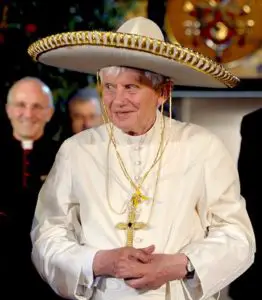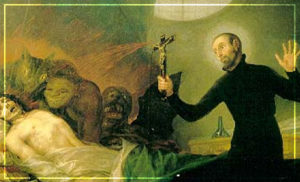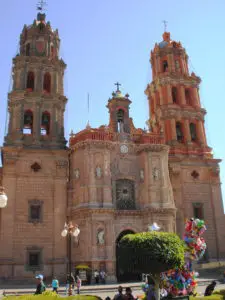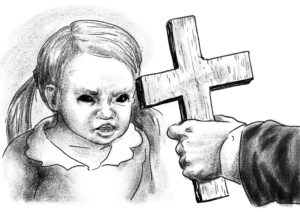 Soothing mariachi music filled the air as crowds gathered outside the Colegio Miraflores in the city of León in the Mexican state of Guanajuato. It was right after sunset on Sunday, March 25th 2012. The people and music coaxed out of his guest quarters Pope Benedict the Sixteenth who was wrapping up his first visit to Mexico. The 84-year-old German-born pontiff made his appearance to the delight of a cheering crowd on his last night visiting the nation of nearly 100,000,000 Roman Catholics. A teenage girl presented His Holiness with a highly ornate sombrero which he wore as he was given a microphone. Benedict stated that in all of his official trips he had never been received with such enthusiasm and love as he had experienced there and, “Now I can say that Mexico will always remain in my heart.” The next day the pope was on a plane bound for Havana, Cuba, and while his visit to Mexico was full of much joy and celebration, the pontiff had a lot on his mind with regard to the second most populous Catholic country in the world. He had gone to Mexico under troubling circumstances. Chief among the pope’s concerns was the rise in the cult of the Holy Death – or in Spanish, “Santa Muerte” – which seemed to be experiencing exponential growth in Mexico along with other religious practices that stray away from the Catholic Church orthodoxy. The stories that Pope Benedict had heard about the increasing power of the Holy Death devotion along with the rise in satanic ritual abuse reported throughout Mexico were some of the real reasons why he visited that country. He was concerned that the Catholic Church was losing its grip on the Mexican people and he wanted to know why. In the wake of the Pope’s visit, the Church would come up with a strategy to solidify its base and try to expel the evil forces that it saw as a threat to its hegemony. The following year, in April of 2013, the President of the Pontifical Council for Culture of the Vatican, Italian Cardinal Gianfranco Ravasi, visited Mexico with the intent in conferring the first “Atrium of the Gentiles” outside of Europe. This meeting was intended to bring together believers and non-believers to talk about the spiritual destiny of Mexico. While open to dialogue to try to figure out what was going on, the cardinal reaffirmed the Catholic Church’s position on the more “demonic” styles of worship going on in Mexico, calling the increasingly popular adoration of the Santa Muerte, “A dark, hellish cult of denial” and that “the greatness of culture and of the true religion is just to celebrate life, and this is exactly the opposite.”
Soothing mariachi music filled the air as crowds gathered outside the Colegio Miraflores in the city of León in the Mexican state of Guanajuato. It was right after sunset on Sunday, March 25th 2012. The people and music coaxed out of his guest quarters Pope Benedict the Sixteenth who was wrapping up his first visit to Mexico. The 84-year-old German-born pontiff made his appearance to the delight of a cheering crowd on his last night visiting the nation of nearly 100,000,000 Roman Catholics. A teenage girl presented His Holiness with a highly ornate sombrero which he wore as he was given a microphone. Benedict stated that in all of his official trips he had never been received with such enthusiasm and love as he had experienced there and, “Now I can say that Mexico will always remain in my heart.” The next day the pope was on a plane bound for Havana, Cuba, and while his visit to Mexico was full of much joy and celebration, the pontiff had a lot on his mind with regard to the second most populous Catholic country in the world. He had gone to Mexico under troubling circumstances. Chief among the pope’s concerns was the rise in the cult of the Holy Death – or in Spanish, “Santa Muerte” – which seemed to be experiencing exponential growth in Mexico along with other religious practices that stray away from the Catholic Church orthodoxy. The stories that Pope Benedict had heard about the increasing power of the Holy Death devotion along with the rise in satanic ritual abuse reported throughout Mexico were some of the real reasons why he visited that country. He was concerned that the Catholic Church was losing its grip on the Mexican people and he wanted to know why. In the wake of the Pope’s visit, the Church would come up with a strategy to solidify its base and try to expel the evil forces that it saw as a threat to its hegemony. The following year, in April of 2013, the President of the Pontifical Council for Culture of the Vatican, Italian Cardinal Gianfranco Ravasi, visited Mexico with the intent in conferring the first “Atrium of the Gentiles” outside of Europe. This meeting was intended to bring together believers and non-believers to talk about the spiritual destiny of Mexico. While open to dialogue to try to figure out what was going on, the cardinal reaffirmed the Catholic Church’s position on the more “demonic” styles of worship going on in Mexico, calling the increasingly popular adoration of the Santa Muerte, “A dark, hellish cult of denial” and that “the greatness of culture and of the true religion is just to celebrate life, and this is exactly the opposite.”
 Indeed, it is very difficult to travel around Mexico these days without seeing the image of the Santa Muerte in various places, from store windows to bus stations, and for more information on the Santa Muerte phenomenon please see Mexico Unexplained episode number 9. It’s estimated that some 10 million people worship the bejeweled, dressed up grim-reaper-looking skeleton known as the Santa Muerte and the phenomenon has nothing to do with the Mexican holiday Day of the Dead, or Día de los Muertos, which is a celebration of those who have passed and is a harmonious blend of Catholicism and ancient pre-Christian traditions. For more information about Day of the Dead in Mexico, please see Mexico Unexplained episode number 5. The Santa Muerte “death cult” is only part of what the Catholic Church sees as a larger problem, however, and the increase in the following of this folk saint and others appears to be a symptom of an underlying moral decay in Mexico and an increase in power by unseen, darker forces which have attempted to gain dominion over all of humanity since the beginning of time. To counter this view, others say that threats of drug violence, dire economic conditions and a breakup of the traditional social framework has led to tens of millions of people in Mexico living lives in despair. The seemingly empowering death cults give these marginalized Mexicans hope and fill the needs not being met by either the family, the Catholic Church or the Mexican government.
Indeed, it is very difficult to travel around Mexico these days without seeing the image of the Santa Muerte in various places, from store windows to bus stations, and for more information on the Santa Muerte phenomenon please see Mexico Unexplained episode number 9. It’s estimated that some 10 million people worship the bejeweled, dressed up grim-reaper-looking skeleton known as the Santa Muerte and the phenomenon has nothing to do with the Mexican holiday Day of the Dead, or Día de los Muertos, which is a celebration of those who have passed and is a harmonious blend of Catholicism and ancient pre-Christian traditions. For more information about Day of the Dead in Mexico, please see Mexico Unexplained episode number 5. The Santa Muerte “death cult” is only part of what the Catholic Church sees as a larger problem, however, and the increase in the following of this folk saint and others appears to be a symptom of an underlying moral decay in Mexico and an increase in power by unseen, darker forces which have attempted to gain dominion over all of humanity since the beginning of time. To counter this view, others say that threats of drug violence, dire economic conditions and a breakup of the traditional social framework has led to tens of millions of people in Mexico living lives in despair. The seemingly empowering death cults give these marginalized Mexicans hope and fill the needs not being met by either the family, the Catholic Church or the Mexican government.
To combat what it believes to be the growing forces of evil in Mexico, the Catholic Church has either deployed or created a vast number of exorcists to deal with what it sees as an abrupt increase in literal demonic possession throughout the country. In fact there are more exorcists currently in Mexico than in any other country on earth. So, what exactly is an exorcism? According to the Catholic Encyclopedia found at New Advent dot org:
“Exorcism is (1) the act of driving out, or warding off, demons, or evil spirits, from persons, places, or things, which are believed to be possessed or infested by them, or are liable to become victims or instruments of their malice; (2) the means employed for this purpose, especially the solemn and authoritative adjuration of the demon, in the name of God, or any of the higher power in which he is subject.”
 The Catholic Church regards demonic possession as incredibly rare and before the 1970s when popular media such as movies and television brought demonic possession and exorcism into the mainstream, there were very few members of the clergy who were trained in this practice. In 1999 the Vatican issued revised rules for conducting exorcisms as it noticed the increase in interest in the ritual. First, a victim must be examined thoroughly by doctors and psychologists to rule out any mental or physical illnesses or evidence of substance abuse. From paragraph 1673 of the Catechism of the Catholic Church:
The Catholic Church regards demonic possession as incredibly rare and before the 1970s when popular media such as movies and television brought demonic possession and exorcism into the mainstream, there were very few members of the clergy who were trained in this practice. In 1999 the Vatican issued revised rules for conducting exorcisms as it noticed the increase in interest in the ritual. First, a victim must be examined thoroughly by doctors and psychologists to rule out any mental or physical illnesses or evidence of substance abuse. From paragraph 1673 of the Catechism of the Catholic Church:
“Exorcism is directed at the expulsion of demons or to the liberation from demonic possession through the spiritual authority which Jesus entrusted to his Church. Illness, especially psychological illness, is a very different matter; treating this is the concern of medical science. Therefore, before an exorcism is performed, it is important to ascertain that one is dealing with the presence of the Evil One, and not an illness.”
The case is escalated to ecclesiastical authorities if medical or basic spiritual help is not effective. Individuals who are demonically possessed may exhibit the following signs:
1. The loss of personality; for example, flying into tantrums or fits of rage
2. A change in the person’s voice
3. Unnatural body postures or contorted facial features
4. Unnatural physical strength
5. Levitation of the person or nearby objects
6. Intense aversion or hatred toward religious objects
7. Coldness in the room
8. Understanding or speaking another language previously unknown to the possessed
9. Biting or cutting of the skin
10. Prediction of future events and knowledge of things unseen
11. Intense bodily pain or other physical ailments not explicable by science
12. The hearing of voices or receipt of other supernatural messages
This is not an exhaustive list.
The exorcist approaches the demon-possessed with a sense of humility. The Church believes that Christ acts through the exorcist to cast out the demon. Standard prayers are used along with oils, incense and candles. The approach an exorcist takes is usually situational. Often, the victim of the possession is physically restrained so as not to cause harm to himself or herself, or to those in his or her surroundings. It may take many attempts for the exorcist to be successful, and sessions may stretch over months or years. Many people in Mexico believe that those who are possessed have a “spiritual inheritance” that gets passed down for 4 generations if the demons are not taken care of and expelled. This is not formal Church dogma, however.
 On May 20th, 2015 the Archbishop Emeritus of Guadalajara, Cardinal Juan Sandoval Íñiguez, along with the Archbishop Jesús Carlos Cabrero of San Luis Potosí and world-renown Spanish demonologist and exorcist Father José Antonio Fortea, gathered together with several Mexican exorcists from around the country to perform a mass exorcism in the Metropolitan Cathedral of San Luís Potosí. Called a Magno Exorcismo the complex ritual was not publicized beforehand so as not to draw attention to the rite. The participants gathered in the cathedral behind locked doors, and began chanting and praying according to a proscribed ritual, including calling on the four directions – north, south, east and west – in the names of specific saints. An important part of the mass exorcism was the call to close The Door of the Abyss. One of the participants hit the floor of the cathedral with a large hammer and called upon the Virgin Mary to close the gates of hell to keep the Devil from escaping. Did the mass exorcism work? Is Mexico now free of demons? As with exorcisms on an individual, the Spanish demonologist who participated in the Magno Exorcismo told reporters that the ritual must be performed many times over the course of several years to make sure it is effective. If the Santa Muerte cult is any indication, the mass exorcism had very little effect, as the numbers of devotees in this folk saint, along with the reported number of exorcisms, have only increased since the event at the San Luís Potosí cathedral.
On May 20th, 2015 the Archbishop Emeritus of Guadalajara, Cardinal Juan Sandoval Íñiguez, along with the Archbishop Jesús Carlos Cabrero of San Luis Potosí and world-renown Spanish demonologist and exorcist Father José Antonio Fortea, gathered together with several Mexican exorcists from around the country to perform a mass exorcism in the Metropolitan Cathedral of San Luís Potosí. Called a Magno Exorcismo the complex ritual was not publicized beforehand so as not to draw attention to the rite. The participants gathered in the cathedral behind locked doors, and began chanting and praying according to a proscribed ritual, including calling on the four directions – north, south, east and west – in the names of specific saints. An important part of the mass exorcism was the call to close The Door of the Abyss. One of the participants hit the floor of the cathedral with a large hammer and called upon the Virgin Mary to close the gates of hell to keep the Devil from escaping. Did the mass exorcism work? Is Mexico now free of demons? As with exorcisms on an individual, the Spanish demonologist who participated in the Magno Exorcismo told reporters that the ritual must be performed many times over the course of several years to make sure it is effective. If the Santa Muerte cult is any indication, the mass exorcism had very little effect, as the numbers of devotees in this folk saint, along with the reported number of exorcisms, have only increased since the event at the San Luís Potosí cathedral.
If the Santa Muerte devotion and satanic rituals are just symptoms of the increase of demonic influences in Mexico, then what do people believe is the cause for the increase in demonic activity in Mexico that would warrant these exorcisms? One of the most seasoned exorcists in Mexico, 80-year-old Father Francisco Lopez Sedano of the Parish of the Holy Cross in Mexico City, who has performed over 6,000 exorcisms in his 40-year career has some explanations. Father Lopez is the National Coordinator Emeritus of Exorcism for the Archdiocese of Mexico and has devoted his life to this subject. He has repeatedly stated that the Devil enters a person’s body because the person has allowed him access. In other words, the victim has in some way let his or her spiritual guard down to permit the possession. The Devil’s whole objective is to create a barrier between God and the individual human. Many people in Mexico believe that people are more easily possessed nowadays because there are just more demonic entities existing among humans on the earthly plane. The faithful cite the 2007 law that legalized abortion in Mexico City that intensified demonic activity  throughout the country. With every baby aborted, so the folk wisdom goes, a new demon gets released upon the earth. The demons look for people to torment and to inhabit, and the same folk wisdom states that there are several ways which a demon can access a possible victim of possession. Many occult practices or even simple good luck rituals are said to make a person vulnerable. A séance a use of a Ouija Board or other “spirit board” to call on ghosts or spirits, even if used in good fun, may be exposing the participants to potential harm. The use of tarot cards has also been cited as possibly dangerous. There are many games that have popped up in Mexico as a result of the internet that have been causing concern among church officials because they are attractive to children, notable among them are the Charlie Charlie Challenge and the Bellena Azul or Blue Whale game. Children are more susceptible to these bad influences nowadays than in any other time in Mexican history, a church official stated. This is because of the breakdown of the traditional family and the fact that many children now come from a home where the mother is working and thus many children are left with a lot of unsupervised time. Charlie Charlie is a game of divination in which two pencils are put on a piece of paper in the shape of a cross and in each corresponding quadrant created by the pencils are the words “sí” or “no”. A ghost called “Charlie” is invoked and participants ask the spirit yes or no questions, watching the pencils for movement. The Blue Whale game consists of a few dozen tasks of increasing complexity agreed to by participants beforehand with the last task usually involving suicide or murder. The very act of engaging in these games, demonologist believe, are incredibly dangerous, and participation in them may even open up portals to Hell. Other things that increase a person’s vulnerability to evil forces according to Mexican believers include things as seemingly innocent as the practice of yoga and even the seemingly magic spell that Disney movies have over children. The extremely faithful would caution us to put away the yoga mat and turn off “Beauty and the Beast.” In a country so haunted by evil and so overrun by demons, apparently one can’t be careful enough.
throughout the country. With every baby aborted, so the folk wisdom goes, a new demon gets released upon the earth. The demons look for people to torment and to inhabit, and the same folk wisdom states that there are several ways which a demon can access a possible victim of possession. Many occult practices or even simple good luck rituals are said to make a person vulnerable. A séance a use of a Ouija Board or other “spirit board” to call on ghosts or spirits, even if used in good fun, may be exposing the participants to potential harm. The use of tarot cards has also been cited as possibly dangerous. There are many games that have popped up in Mexico as a result of the internet that have been causing concern among church officials because they are attractive to children, notable among them are the Charlie Charlie Challenge and the Bellena Azul or Blue Whale game. Children are more susceptible to these bad influences nowadays than in any other time in Mexican history, a church official stated. This is because of the breakdown of the traditional family and the fact that many children now come from a home where the mother is working and thus many children are left with a lot of unsupervised time. Charlie Charlie is a game of divination in which two pencils are put on a piece of paper in the shape of a cross and in each corresponding quadrant created by the pencils are the words “sí” or “no”. A ghost called “Charlie” is invoked and participants ask the spirit yes or no questions, watching the pencils for movement. The Blue Whale game consists of a few dozen tasks of increasing complexity agreed to by participants beforehand with the last task usually involving suicide or murder. The very act of engaging in these games, demonologist believe, are incredibly dangerous, and participation in them may even open up portals to Hell. Other things that increase a person’s vulnerability to evil forces according to Mexican believers include things as seemingly innocent as the practice of yoga and even the seemingly magic spell that Disney movies have over children. The extremely faithful would caution us to put away the yoga mat and turn off “Beauty and the Beast.” In a country so haunted by evil and so overrun by demons, apparently one can’t be careful enough.
REFERENCES (This is not a formal bibliography)
BBC “Mass Exorcism Performed at Mexican Church” 26 Nov. 2013
Various articles from the Catholic News Agency
The Catholic Catechism
